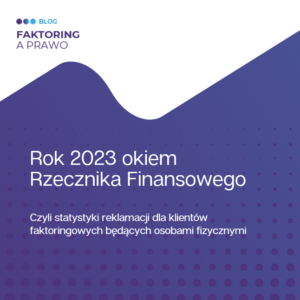Crif Ltd. 2021 once again conducted a survey (questionnaires) on fraud in the factoring and leasing industry for the Risk & Supervision Meeting conference. Due to the theme of the Blog, we will focus on the survey of the factoring industry.
The survey will be discussed in full at Risk & Supervision Meeting 2021 Conference. We encourage you to register and participate in the event. Risk & Supervision Meeting conference is organized annually by CRIF Ltd. - This year it will be held on 09.09.2021. (about which more HERE). We already have the opportunity to share our first insights into the survey results.
This year's survey was conducted in May 2021, with the goal of identifying common risks, threats and trends in the sphere of fraud in the leasing and factoring sectors, with the target result of defining and creating modern anti-fraud solutions for both industries. As in the previous year, this time we are once again tempted to analyze the results of the survey and our own conclusions related to factoring fraud trends. However, this time it will be enriched with references to the 2020 results. Of interest will be the aspect of the impact of the coronavirus pandemic, as noted by factoring companies, on fraudster activities.
- Methods to combat abuse. Again, external business information registers were cited by respondents as the best method of combating fraud. The worst performers were industry solutions based on Article 106d of the Banking Law (i.e., information exchange systems, databases on extortion, fraud, convictions, etc.).
Comment: The group of anti-fraud methods is extremely broad, and respondents also pointed to this fact. Here we can include standard internal procedures (compliance), anti-fraud training, "fraud-proof" documentation, learning from mistakes and analyzing internal and external cases, whistleblowing, the applied KYC (Know Your Customer) principle, internal auditing. Survey respondents pointed to the usefulness of Insurer Registries. Interestingly, in the case of the leasing industry, industry solutions based on Article 106d of the Banking Law were also rated the worst, despite being perceived as the best in 2019.
- Fraud detection techniques. Among the techniques used by factoring companies to detect fraud, the most popular include anomaly detection and network analysis, analysis of publicly available data sources (nearly 92%) and and case management (workflow) (slightly over 80%).
Comment: Compared to the previous year, we do not see a significant change here. The multitude of tools for verifying factoring and other factoring participants is still sizable. At the end of 2021, this group is finally to be joined by the National Register of Debtors. This year 3 companies have declared application of business (decision) rules engine, in 2020 none indicated the use of this technique. The market for comprehensive factoring systems with analytical tools for financial documents as JPK_VAT, types and types of transactions of the factor, and cooperation between the factor and its counterparties before the factoring limit is granted is growing, which should be assessed definitely positively. The more comprehensive the system, the greater the chance of detecting probable fraud, as the respondents themselves noted.
- Level of expenditure. 7/12 of the factoring companies surveyed set the level of anti-fraud spending at an appropriate level, while the remainder (5/12) set it too low.
Comment: There is a difference compared to 2020, where the proportions in favor of under-spending were reversed (60 % respondents thought so then). The result is still not satisfactory given the financial implications of factoring fraud. As we did last year, we encourage you to include modern IT solutions (analytical systems) in your annual expense budgeting, as well as for trainings on the subject of counteracting factoring frauds.
- Obstacles. The lack of information on all unreliable customers (100%), the lack of cooperation between the insurance and factoring industries due to legal restrictions (80%), as well as the lack of easy access to databases maintained by government authorities, i.e. CEPiK (60%) and the inability to verify the authenticity of documents, e.g. PIT/CIT declarations (60%), were identified as obstacles to countering fraud.
Comment: The situation of information exchange in the finance and insurance sector has not improved despite the demands raised in this regard. Getting to the exorbitant requirements imposed by regulations (e.g., RODO) in terms of processing personal data, among other things, continues to be a challenge for a factoring company wishing to protect its interest and an insurer attempting to remain as legally compliant as possible. Perhaps shifted again KRZ will be appreciated by the industry, and the results of this will already be seen in the survey conducted next year. Undoubtedly, the following should still be pointed out as a big negative Lack of a database of concluded factoring agreements and global assignments on customers reported for factoring. Still, other (competing) factoring companies usually find out about the fact of the factoring agreement after the fact, when the debt resulting from it appears in the databases, not when the factoring limit has already been assigned.
- Gaps in access to information sources. Lack of access to information sources was cited as deficiencies in access to information on the affiliation of JDGs with individuals appearing in the KRS and to the register of bailiff foreclosures (both 83% each). Also ranked high were the lack of a single dedicated business intelligence service linking all sources together with the results of Internet searches, as well as the lack of access to information on bailiff foreclosures (both 67% each).
Comment: In the near future we are unlikely to see a single system combining the capabilities of verification and analysis of the factor, and that even before the factoring limit is granted. Regarding cooperation with bailiffs, it is worth adding that in fact the lack of a single tool in the bailiffs' structures that is also available to a wider audience strongly complicates the verification of counterparty debts. There is no possibility of checking established bailiff seizures, as well as no possibility of generating inquiries about the debtor before obtaining an enforcement / security title. Meanwhile, it would be reasonable to be able to obtain such knowledge already at the stage of debt maturity. One can consider whether such a problem would be solved by a power of attorney from the factor, however, it would have to touch more on ongoing proceedings.
- Effectiveness of methods. A stand-alone internal team dedicated to detecting irregularities and fighting fraud, as well as IT solutions for detecting and preventing fraud, were identified as the most effective methods.
Comment: As last year, the respondents' assessment reflects our beliefs on the subject. An effective fight against factoring fraud must be based on the solid cooperation of a team, i.e. people who have the right knowledge, experience and are properly trained to catch the smallest signals indicating the possibility of fraud. However, even the most skilled group of people cannot cope with analyzing thousands of transactions sometimes, hence the increase in the share of software and IT systems here is quite understandable, especially on smaller factoring volumes, where manual catching of anomalies may be disproportionate to the person-time resources allocated.
- Number of frauds blocked. Surveyed factoring companies put the estimated number of blocked fraud attempts at 1-100 (yes 83%), while nearly 17 % respondents say the number is between 100 and 300.
Comment: Last year we highlighted the potential for rogue counterparties to exploit the coronavirus pandemic for fraudulent purposes. In last year's survey, the number of blocked frauds was put by 100% respondents at 1-100. This year, however, 2 companies have already noted a higher share of likely frauds in factoring transactions above 100. In addition, 67% respondents answered that they had experienced a single significant fraud event within 3 years, where in 2020. 4/5 factoring companies indicated that they had not recorded such an event. This means that in 2020, however, the - previously signaled - intensification of fraudulent activities increased. This is in line with the principle "propensity for fraud increases during a crisis," and undoubtedly there was one in 2020.
- The impact of the COVID-19 pandemic on the factoring market. Respondents were asked about interest in their product offerings during the coronavirus pandemic (68% respondents saw a decrease in interest), the impact of a decrease or increase in interest on budget and anti-fraud activities (83% maintained budget despite the decrease in interest), or the perceived correlation of the pandemic and fraud (83% saw no correlation).
Comment: The conclusion from the responses of factoring companies is that, in the opinion of respondents, fraudsters did not target the factoring industry. This may have been related to the general decrease in the number of transactions and volume during the pandemic (related to bankruptcies, closures or temporary disruptions of companies) - the risk of catching a fraudulent transaction increased when the overall number of invoices to be verified decreased. Nevertheless, I do not share the conclusion that there is no correlation between the pandemic and the number of fraudulent transactions. The actual statistics are masked by the lack of detection resulting from the repayment of many fictitious receivables by both recipients and factoring companies themselves, including in recourse. In the hottest period of the pandemic where business "sat down" such situations occurred and as a result of repayments and subsequent funds from "shields" were undetectable and sometimes not treated as incidents or frauds.
Other conclusions we derive from the analysis of survey results:
- The observation of an increasingly lower threshold for entry into the world of financial crime remains valid. It becomes all the more telling when one considers the simple joint-stock company that has been in operation since 1.07.20201, which we wrote about HERE. The fact that the minimum capital will be only 1 zloty, a new body (board of directors) has been created, and at the same time there is no provision of Article 299 of the Commercial Companies Code, appropriate as in the case of limited liability companies and joint-stock companies, makes this entity suitable for fraud purposes (both on the part of the factor and the recipient). Given the untrodden path in the Polish market (and the related lack of confidence of factoring companies) and the lack of a uniform approach of tax authorities to this form of company, fraud involving a simple joint-stock company is unlikely to be recorded in mid-2021. However, this situation may change in the future.
- We stand by our position that the most important reform of this year we call b2sb (sole proprietors partly like consumers) (we wrote about it here in point 1 in terms of factoring vs. generally here, and I wrote about it personally on LinkedIN -> "B2sb reform an invitation to financial fraud? [subjective]." will pose a very big risk to the factoring industry, and the effects of this may be seen in the next few years. So, will the most model-fraud customer of a financial institution (a limited liability company) be replaced in a while by a sole proprietor? I will venture a thesis that this may be the case.
- There is a strong overlap between the results of surveys in the factoring and leasing industries, especially when it comes to evaluating the selected methods of combating fraud or the most effective methods of combating fraud, which are an independent internal team dedicated to detecting irregularities.
- Finally, last year we drew attention to the small (on a market scale) number of entities that participated in the survey, while according to various sources, factoring services in Poland are provided on a commercial scale by at least 25-40 entities, and if we also take into account the entities that provide such services for their own groups, or traces, the total number of entities should close in 60-100. This year, 12 factoring entities and 7 leasing entities participated in the survey, which in the case of factoring - is an increase of 100%. However, this is still only a "slice" of entities operating in the factoring market, although the increase in interest in the survey is definitely worth noting, and here kudos to CRIF.
- It is encouraging that financial companies have not forgotten the need for training in countering factoring fraud. Such training, however, because of the restrictions took the form of online training, which we ourselves have experienced while conducting such trainings. Perhaps this formula made it easier to conduct such trainings.







